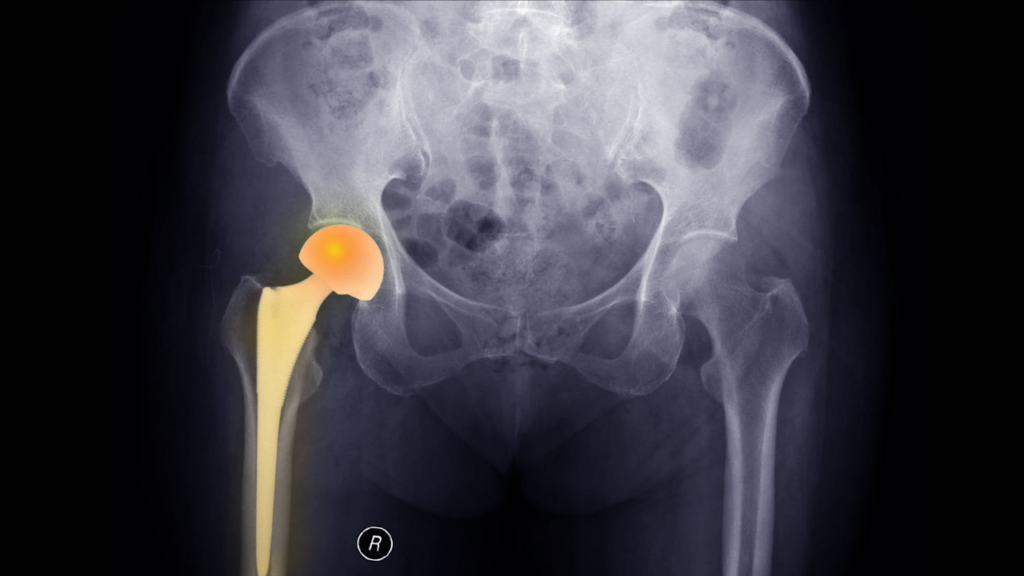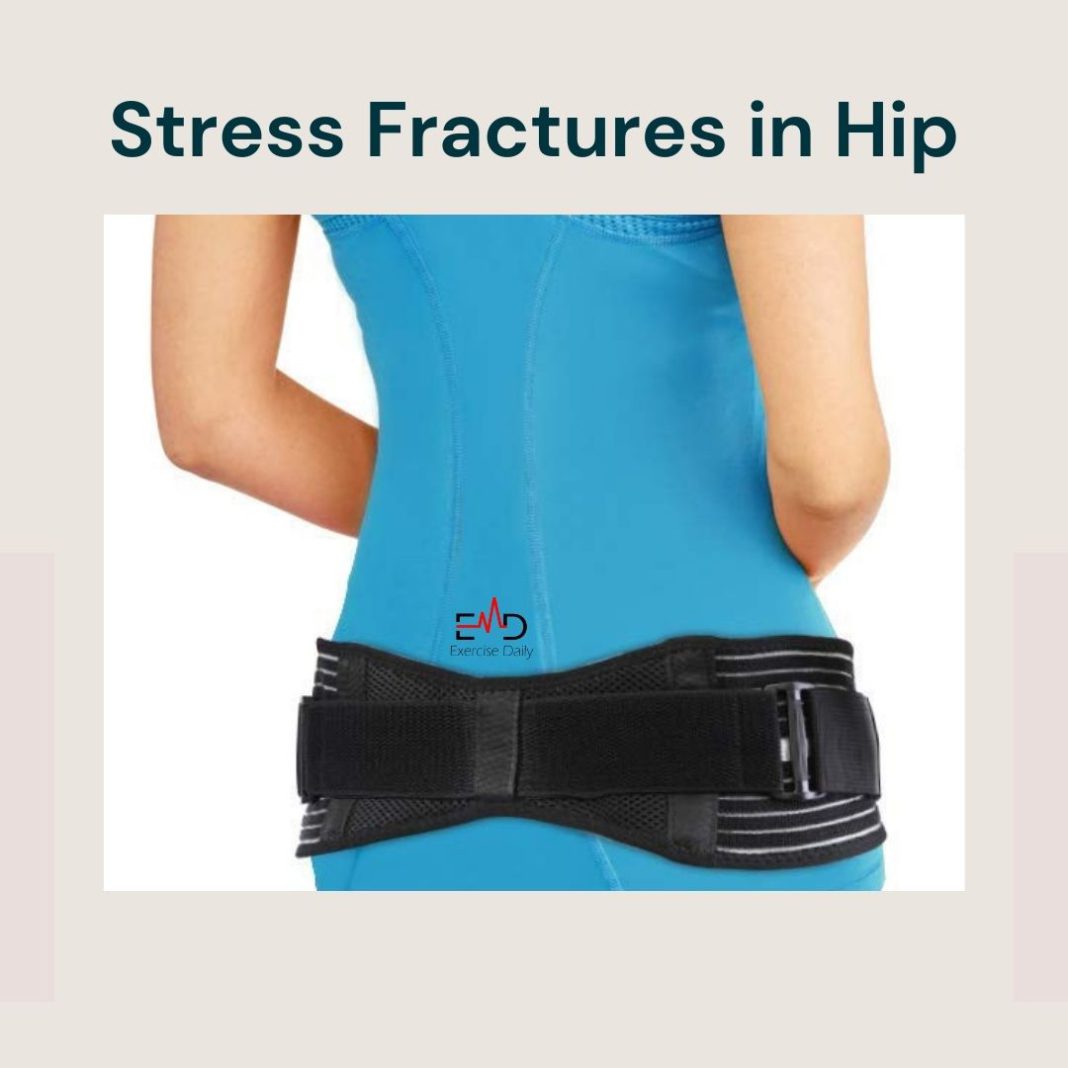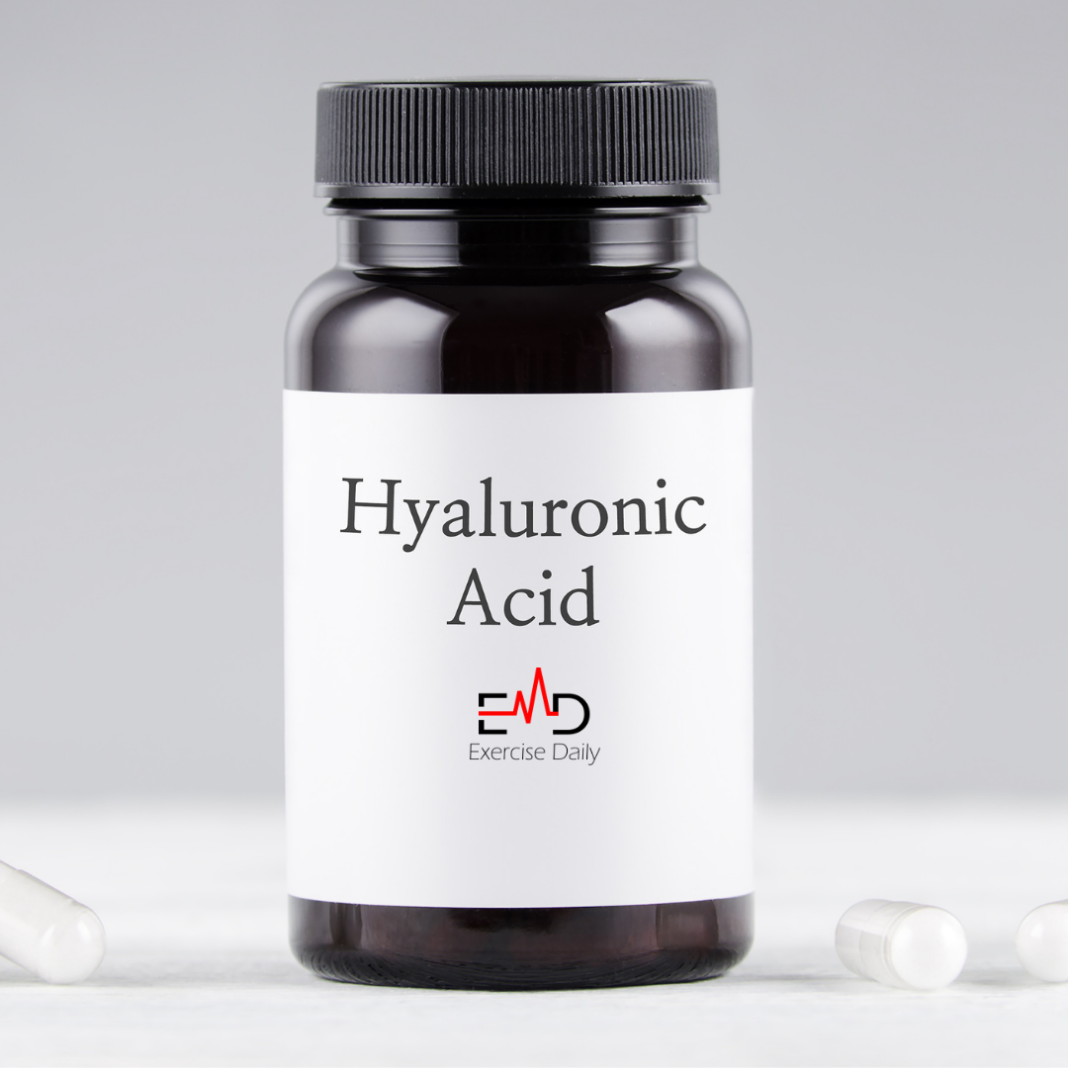Exercise Daily – Stress fractures in hip are injuries to the region surrounding the ball of the ball-and-socket hip joint. They occur when the joint is under chronic stress. Breaking hips is something that most people associate with the elderly. However, stress fractures may occur at any age.
Stress fractures in the hip are bone injuries that occur as a consequence of excessive physical exertion.
A stress fracture is caused by repeated micro-trauma to the bone, which results in bone breaking. A fracture happens when the body is unable to keep up with the stresses pushing on the bone over an extended period of time.
In contrast to a high-energy hip fracture caused by a fall or a pathologic hip fracture caused by osteoporosis, tumors, or infections, this kind of fracture is not painful.
Symptoms of a Hip Stress Fracture
People who suffer from a hip stress fracture are most typically long-distance runners, military recruits, or persons who participate in high-impact sports.
People will typically complain of aching groin pain that worsens with activity. It alleviates by resting the groin muscles. If you have recently increased your level of exercise, such as by increasing your running miles, you will most likely notice symptoms.
After stress fractures in hip, the bones are often able to return to their original position. In fact, these fractures frequently do not even appear on a standard X-ray, particularly in the early stages of the disease.
When a stress fracture is left untreated, and the bone continues to deteriorate, the fracture might displace. This might also cause the bones to get out of alignment.
When a healthcare physician suspects a stress fracture of the femoral neck in the hip, they are often quite worried. The practitioners would typically instruct their patients to use crutches until the proper diagnostic tests have been completed.
You will read more about femoral neck hip fracture later in this article.
Causes of Stress Fractures in Hip
In the case of a stress fracture, repeated damage to the bone results in the fracture of the bone. When bones are healthy, they are continually going through a cycle of renewal and resorption. Whenever an old bone is reabsorbed, a new bone is formed.
If the healing mechanism is unable to keep up, the bone will finally shatter!
Hip stress fractures most often develop directly below the ball of the ball-and-socket hip joint. The femoral neck is the part of the bone that is located in this region.
Even while stress fractures may develop in other parts of the hip and pelvis and the femoral neck, the femoral neck is the most prevalent and most worrying region for hip stress fractures.
Femoral Neck Hip Fracture
A femoral neck fracture is a form of hip fracture in the thigh bone (femur), right below the ball of the ball-and-socket hip joint. It is the most common type of hip fracture.
This form of fracture causes the ball of the femur to get separated from the remainder. It usually results in groin discomfort that becomes worse when you put weight on the afflicted leg.
Stress fractures in hip are more prevalent in the elderly, although they may also develop in physically active younger individuals. This can be a result of falls, car accidents, and, on rare occasions, stress fractures caused by misuse of the hip joint.
A femoral neck fracture, or any hip fracture, should be treated as soon as possible in order to minimize the risk of further problems developing.
Complications and Issues of Concern
When assessing the consequences of a hip fracture, it is crucial to consider mobility and quality of life. In addition, pain and discomfort may accompany. It is possible to develop severe osteoarthritis after this sort of injury.
After receiving such an injury, the chance of mortality increases considerably among the senior population. Overall death rates hover around 6% during hospitalization and 20 to 30% over the first year after an accident.
Mortality may occur as a result of acute problems, such as infection, or as a result of delayed effects. These may include pneumonia and cardiovascular disease, and lack of mobility.
It is critical to get treatment for a hip fracture as soon as possible. According to a certain study, the mortality and complication rates in elderly fracture patients may be reduced if surgery is performed within 48 hours after the fracture.
A femoral neck fracture might be difficult to treat due to the thinness of the bone in that location. Furthermore, osteoporosis is often a significant factor.
In addition, the blood flow to the broken piece of bone may be compromised at the time of the injury. It makes it more difficult for the bone to repair.
Osteonecrosis is a disorder in which the bone cells die as a consequence of a loss of blood supply to the bone. This might result in a bone collapse in the location of the damage sustained.
Diagnosis
An X-ray confirms that a hip stress fracture has occurred. Although certain stress fractures in the hip appear in X-rays, other X-rays may seem to be normal in appearance.
The use of magnetic resonance imaging (MRI) or a bone scan may be used to determine whether or not a stress fracture has occurred in the case when the injury is still questionable.
Rating the Severity of the Fracture
A hip X-ray is often used to identify a femoral neck fracture, which may be determined by your healthcare professional. In certain circumstances, such as with stress fractures in hip, you may have symptoms, yet your X-ray may not reveal anything noteworthy.
When using a computed tomography (CT) scan, magnetic resonance imaging (MRI), or a bone scan, it is probable that the fracture may be apparent.
When determining the severity of a femoral neck fracture, the Garden classification system is used. There are four phases, or kinds, of fracture, with type I being the least severe (an incomplete, non-displaced fracture; a partial break).
On the other hand, type IV is the most severe (a complete, non-displaced fracture; a complete break) in which the bones are separated and out of alignment.

In determining the most appropriate course of treatment for your fracture, your medical team will utilize this categorization to guide their decision-making.
Treatment Options
Avoid any exercises that create stress on the hip joint immediately if a stress fracture is suspected in the hip. This may also help to lessen pain or discomfort in certain cases greatly.
If a stress fracture is suspected, it is recommended that pain medicines be avoided until the fracture has been properly treated. In the meanwhile, masking symptoms might result in a more catastrophic breakdown.
If you are only experiencing discomfort while you are running, you must stop running immediately. The usage of crutches should be considered if the discomfort develops when walking.
The most crucial notion to remember is to remain below the threshold of discomfort. In most cases, if you avoid activities that worsen your symptoms, stress fractures in hip may heal on their own without the need for surgical intervention.
If there is a possibility that the fracture could relocate, surgery will be required. The use of this procedure is often explored if the break is substantial and positioned on the femoral neck, which is less likely to mend on its own without assistance.
When a femoral neck fracture occurs, surgery is the most frequent treatment option. However, conservative care may be the best option if surgery would be too risky for you.
Pain management, resting your hip joint, and physical therapy once the bone has healed are all examples of conservative therapies for hip fractures.
Surgical Treatment
The following are the most significant factors to consider while undergoing surgical treatment:
Degree of Fracture Displacement
Open Reduction and Internal Fixation are performed on patients according to their age.
During your operation, your surgeon would physically realign your misplaced bone and use surgical pins, screws, or nails to keep your bones in place while they recover. If you have a dislocated bone, your surgeon may recommend a bone graft.
Many variables influence whether or not you can bear weight on your repaired hip once it has been replaced. Before beginning any treatment or fitness program, consult with your surgeon.
As your bones recover, you should notice a decrease in your discomfort level. If you suffer from osteonecrosis, you may potentially need hip replacement surgery at some point.
Need For a Partial or Full Hip Replacement
After the bones of the ball-and-socket joint are removed and replaced with metal or ceramic implants, the procedure is known as hemiarthroplasty (partial hip replacement) or complete hip replacement.
If you’ve suffered a displaced fracture, hip replacement may be the best option for you because of the difficulties and low healing rates associated with surgical treatment of these sorts of fractures.
On the other hand, in younger patients, surgeons will make every effort to avoid the need of doing a partial hip replacement if at all feasible. Hip replacements perform really well in people who are not particularly active, but they tend to fail in those who are younger and more active.
In most cases, rehabilitation starts immediately after a partial or whole hip replacement procedure. As their discomfort diminishes, many patients are able to advance swiftly to walking with their whole weight supported by the implant.
Knowing the exact site of your fracture might assist your healthcare professional in determining the optimal treatment plan for your condition. Stress fractures in hip that result in compression of the bone tend to be more stable than hip stress fractures that result in the tension of the bone.
Based on the X-ray and magnetic resonance imaging (MRI) data, your practitioner can decide whether or not the stress fracture is stable.
Top 10 Hip Stress Support Braces
DonJoy Sacroiliac Joint Support Belt
This joint support belt, which is available in sizes ranging from small to x-large, is perspiration-wicking and excellent for prolonged usage.
Additionally, it contains silicone grip strips and mesh material in order to keep the support brace in place. Undergarment wear is excellent for the DonJoy Sacroiliac Joint Support Belt because of its low-profile design.
Due to the use of a revolutionary mechanical advantage pulley system, this belt provides smooth compression. It includes a velcro fastening for easy on/off, and you may adjust the tension to your liking.
The Bottom Line
Nevertheless, the low-profile design of this sacroiliac joint support belt enables you to wear it beneath your clothes because of its simple pull handle and rapid, customizable comfort.
Pros
- Can be worn underneath clothing
- Patented mechanical advantage pulley system
Cons
- A little expensive
- The plastic strings may separate from velcro
- Uncomfortable to wear while sitting
OPTP SI-LOC Sacroiliac Support Belt
Back spasms, lower back pain and stress fractures in hip may all alleviate by using this sacroiliac support belt.
You may wear this belt beneath your clothing since it’s breathable and lightweight. Additionally, the nude color is a big plus. The belt’s anti-slip clasp may adjust well to your own preference. Thanks to a hook-and-loop closing mechanism!
Medical-grade, non-slip pads that come with an OPTP belt keep it from slipping. Additionally, this SI joint belt features a distinctive tapered shape, which distinguishes it from some of the others on our list.
To guarantee uniform pressure distribution and comfort over extended durations, the belt has been modified broader in some places.
The Bottom Line
There is no return or exchange policy for this product, even if it isn’t explicitly stated in the product description. It’s worth noting, though, that it’s reasonably priced and has features like an anti-slip clasp and medical-grade, nonslip padding.
Pros
- Includes durable multi-grade, non-slip pads and anti-slip buckle
- Has a tapered design for even pressure distribution
- Easy to wear even under clothing
Cons
- No return or exchange policy
- Velcro may wear out after some time
Vriksasana Posture Sacroiliac Hip Belt
It is intended to not only treat joint discomfort, but also lower back pain, leg nerve pain, and also stress fractures in hip. This hip belt by Vriksasana is made of high-quality materials. It also aids in the stabilization of the sacroiliac joint, which may be affected by hypermobility or inflammation.
It is constructed of breathable, lightweight fabric as well as moisture-wicking neoprene. The anti-slip silicone slips on the bottom of the item assist to keep it from sliding around while being worn.
There are two belts on the Original Sacroiliac Hip Belt, which enables you to adjust the degree of compression. Additionally, owing to the secondary strap, you may personalize the amount of additional compression that is required over a specific location.
The Bottom Line
This company recommends that the support belt be worn 24 hours a day, seven days a week for two weeks to guarantee proper pain relief and rehabilitation.
Having said that, it may be pretty effective, and it is reasonably priced. It is also available in nude and black colors.
Pros
- Has dual adjustable options
- Contains anti-slip silicone slips
- Made of moisture-wick neoprene
Cons
- Velcro support is not good
- Fewer size options
BODYMATE Compression Brace for Hip
From the standpoint of design and functionality, this compression brace is considerably different from the other braces on our list.
For example, unlike the other compression braces, the BODYMATE Compression Brace doesn’t simply cover the hip portion, but the legs as well. It features an adjustable latching strap that may be worn on either the left or right leg depending on your preference.
This unique device is intended to aid in the treatment of stress fractures in hip, hamstring strains, sciatica, and other sorts of hip, quad, and groin ailments, among others.
The right belt for you may be if you have muscle pull, lower back discomfort, SI joint pain, or problems with your hip flexors and hamstrings.
Additionally, because of the steady compression relief it gives, it may help to shorten your recuperation period while also increasing blood flow in certain places.
The Bottom Line
However, the device is one of the more affordable solutions on our list, and the manufacturer gives a 30-day return policy on the goods. For those who are working with a limited budget, this may be the appropriate belt for them.
Pros
- Made of breathable neoprene material
- 30-day return policy
- Latching strap for your leg
Cons
- Difficult to remove
- Small in size
Bauerfeind Unisex SacroLoc Back Support
The two-part viscoelastic foam pads on this belt provide soothing pain relief while also providing support.
It works by massaging the trigger points surrounding the hip to reduce pressure in the region where the sacroiliac and pelvic bones meet. It is a common source of back pain.
This massaging action relieves pain and promotes blood circulation. Both of these contribute to the healing process and speed up the recovery in case of stress fractures in hip. It also contains tension straps that let you customize the intensity of compression to meet your specific needs.
The belt assists with lower back discomfort and associated symptoms, arthritis, joint instabilities, and sacroiliac (SI) joint instabilities, and stress fractures. It is available in a variety of colors and sizes.
Fabricated from a soft, breathable, lightweight cloth that is machine washable and does not absorb heat, this item is ideal for warm weather.
The belt has been developed to fit the curve of your body and may be worn either below or above your garments to provide additional coverage.
Another feature that customers will love is the number of different size selections available, a total of seven to be precise. It appears to be only available in the color blue at this time.
The Bottom Line
For those who have a good budget, this is an excellent option to explore!
Pros
- Cushion pads with viscoelastic properties for relieving pain
- Adapts to your body’s natural contours
Cons
- Lesser color options
- Expensive
BackWonder Belt by GNR
This belt seems to be narrower in width than many of the others on our list, but it is available in four sizes to ensure a comfortable fit. BackWonder guarantees that their belt will remain firmly in position on your hips.
This is because of the ergonomic design created by a physical therapist with extensive experience. The addition of two non-slip inner panels lets you move about freely and comfortably as you like.
The BackWonder belt was designed to provide relief from joint discomfort, leg and lumbar pain, as well as hip pain and stiffness.
It also helps to stabilize the pelvis, hips, and SI joints, which aids in the relief of pain symptoms connected with them. They are super effective for stress fractures in hip bones.
Designed with comfortable neoprene and a moisture-absorbing lining, this high-quality, long-lasting belt will last you a long time. It is suitable for men and women of all ages, and it may be worn comfortably beneath your clothing without irritating the skin or limiting your movement.
The Bottom Line
After everything is said and done, this cost-effective solution boasts an ergonomic design and a moisture-absorbent lining, making it an excellent choice whether you live or work in hot weather. This belt seems to run big, so you may need to get a smaller size.
Additionally, some customers have mentioned that it does not always remain put.
Pros
- Moisture absorbent lining
- Ergonomic design
- Double side-pull elastic for extra support.
Cons
- Metal buckle breaks easily
- May not stay intact
Serola Sacroiliac Hip Belt
This hip belt is evidence that larger does not always equate to better. Despite the fact that it is the smallest (width) belt on our list, it has a plethora of advantages.
It helps to restore the right balance of resilience and resistance to your joints, allowing you to regain normal mobility in your joints.
Aside from that, since the stress fractures in hip belt offer stability for your spine, you will notice a rise in the strength of your legs, hips, and lower back.
The tacky quality of the Serola Sacroiliac Hip Belt, which adds additional traction, ensures that the belt will remain in place even during intensive exercise. It is made of open-cell urethane foam, which is breathable, hypoallergenic, and moisture-wicking
The Bottom Line
If you have sensitive skin, this hypoallergenic belt is an excellent alternative. It is available in sizes ranging from small to extra-large, has a sticky surface for enhanced grip, and is constructed of a moisture-wicking substance.
Pros
- Provides additional grip
- Moisture-wicking
- Hypoallergic
Cons
- Expensive
- Bunches up underneath clothing
Pro Enrichment Hip Belt
The Pro Enrichment hip belt, which is suitable for both men and women, is constructed of neoprene, spandex, and nylon and may be worn discreetly below your clothes.
You can wear it while sleeping when you exercise on a regular basis, or while participating in sports. The treatment may give relief for hip or pelvic instability, lower back pain, sciatica pain, joint inflammation, and sacroiliac joint (also known as SI joint dysfunction).
One of the most important characteristics of the Pro Enrichment Sacroiliac Hip Belt is the pelvic support belt hook with loop fasteners, which allows the belt to be donned and removed without difficulty.
In addition, the lower back brace, which helps to support the lower back, sacrum, and pelvis, is a crucial component of the system. Additionally, there is an additional strap on the back belt that allows you to modify the degree of compression that you desire.
The Bottom Line
The belt is reasonably priced and may be worn when sleeping, exercising, or participating in sports.
Pros
- Easy to wear during sports, work or even sleep
- Invisible underneath clothes
Cons
- Not very broad
- May lose slip resistance quickly
PlayActive Hip Belt
In addition to being breathable and composed of lightweight, medical-grade material, this belt also has anti-slip properties to keep you safe.
It is good for both men and women and comes with elastic tension straps that enable you to customize the tightness and support to your liking. The PlayActive belt is 3.5 inches wide and accommodates hip measures ranging from 36 to 40 inches in circumference.
It may be worn on top of or below your clothes and eases tension, discomfort, and pressure associated with pelvic instability and stress fractures in hip.
Furthermore, it has a sturdy loop and hook closures, as well as smart tabs, which make it simple to use and remove.
The Bottom Line
The only problem with this hip belt is that it is visible when worn beneath clothes and that it does not remain in place on the hips.
However, remember that you should fall within the specified measurement range and that there is a money-back guarantee if you do not.
Pros
- Easy loop-and-hook closure
- Elastic tension strap for adjustment
- Anti-slip feature
Cons
- Appears bulky underneath clothes
- Fewer sizes available
- May not remain in place
Sacroiliac Compression Brace
One-handle pulley system allows for fast and easy fit adjustment on this Sacroiliac brace, which is available in one size fits all. Furthermore, the brace has two detachable pressure pads that you might use on painful or inflamed regions.
It provides an additional layer of support and compression to the affected area. Wearing this brace all day is possible because of the thin and lightweight mesh band that allows for maximum breathability.
When it comes to keeping the brace in place on your hips, medical-grade velcro does wonder. It is reportedly 10 times stronger than regular velcro. It is equally good for both men and women and accommodates hip circumferences ranging from 32 to 50 inches.
The Bottom Line
If you’re looking for something lightweight, breathable, and simple to use, this is an excellent option.
Pros
- Easy adjustment
- Medical-grade Velcro to keep SI belt in place
- Has pressure pads
Cons
- Expensive
- Does not remain intact
- No proper instructions for using pressure pads
Buying Guide For Hip Braces
All stress fractures in hip belts are not the same, and some might even do more damage than good. Therefore, it is critical to understand the characteristics of an effective belt. Consider the following points before making your purchase of a sacroiliac hip belt.
Size
A loose belt will be a complete waste of money because it will not give sufficient compression to aid the joints. Thus, this is an extremely critical consideration.
The use of a SI belt that is excessively tight, on the other hand, might worsen the problem, producing more pain and suffering. If you want to be sure you get the right size, pay close attention to the sizing chart before you buy.
Material
Choose a garment that is thin, lightweight, and breathable so that you may comfortably wear it for long periods of time. If you want to wear your SI belt to work, church, or any other place where others will see it, you will need an option that is completely invisible below your clothes.
Adjustment Choices
Pay close attention to specific distinguishing characteristics, such as anti-slip buckles, dual adjustment choices, and ergonomic designs.
These not only aid in the improvement of the efficacy of the belts, but specific aspects also increase the degree of comfort and speed up the healing process.
Frequently Asked Questions
Can you walk with a hip stress fracture?
As the discomfort subsides, you may gradually return to typical activities such as walking or other physical activity. Additionally, cross-training activities such as cycling and swimming are permitted to keep your fitness level up.
Your physiotherapist will prescribe exercises to help you strengthen your hips and lower legs in order to prevent future bone stress from occurring.
What does stress fracture in hip feel like?
The majority of individuals who suffer from stress fractures in hip have discomfort in the front of the groin when standing or moving about. The majority of the time, rest will alleviate the discomfort.
Patients may walk with a limp. Exercises that are physically demanding, such as jogging and climbing stairs, may be so painful that the patient must refrain from participating in them.
Can you have a stress fracture in your hip?
Stress fractures are more common in the lower legs and feet, which bear the brunt of the body’s weight. They may, however, manifest themselves in the hip.
It is normal for runners to have stress fractures in their hips when they abruptly increase their mileage or begin a more strenuous training regimen.
Do hip fractures heal on their own?
It is possible for a fractured hip to mend without the need for surgery. In rare circumstances, if the hip is broken, it may not be necessary to have surgery to repair the fracture.
A fractured bone, for example, may mend spontaneously if the ends of the broken bone are affected, or if the ends of the shattered bone were forced together as a result of significant force from an accident or fall.
Does a stress fracture hurt all the time?
At initially, you may not even feel the discomfort associated with stress fractures in hip. However, the condition will progressively deteriorate with time.
Tenderness generally begins at a particular location and diminishes as the patient relaxes. It is possible that you may experience swelling around the uncomfortable spot.
Conclusion
Hip stress fractures may develop into potentially severe injuries that need prompt medical attention.
It is important to note that although not every hip stress fracture necessitates surgical intervention, an urgent change of activity is necessary in order to reduce symptoms and enable the bone to heal.
A neglected hip stress fracture may result in major consequences, the most severe of which is fracture displacement requiring surgery. It can also result in hip osteonecrosis, which is a degenerative disease of the hip joint.
You might use one of the hip braces to see if it relieves the pain. Don’t forget to share your experiences in the comments section below.




